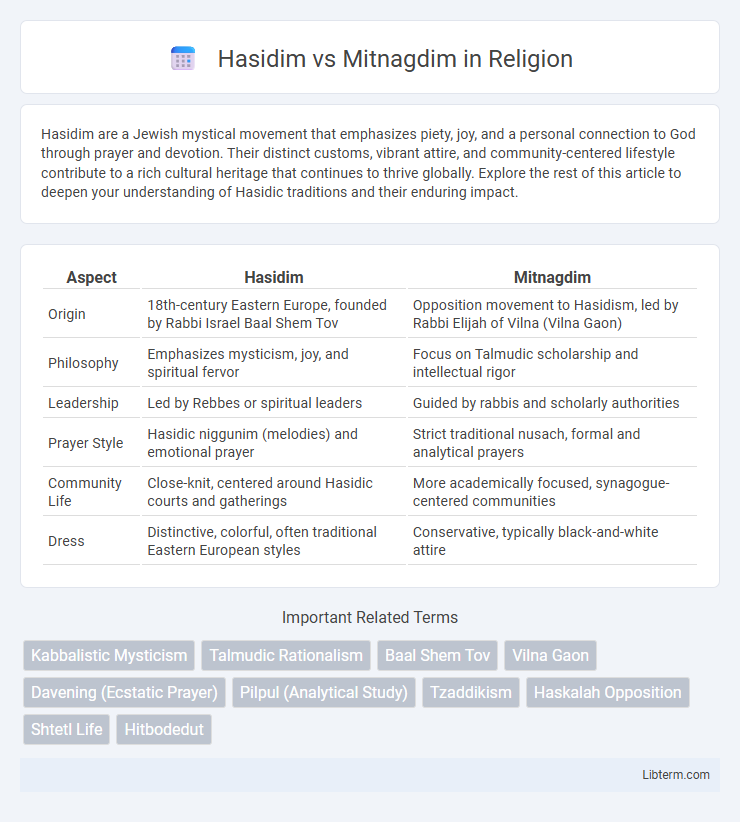Hasidim are a Jewish mystical movement that emphasizes piety, joy, and a personal connection to God through prayer and devotion. Their distinct customs, vibrant attire, and community-centered lifestyle contribute to a rich cultural heritage that continues to thrive globally. Explore the rest of this article to deepen your understanding of Hasidic traditions and their enduring impact.
Table of Comparison
| Aspect | Hasidim | Mitnagdim |
|---|---|---|
| Origin | 18th-century Eastern Europe, founded by Rabbi Israel Baal Shem Tov | Opposition movement to Hasidism, led by Rabbi Elijah of Vilna (Vilna Gaon) |
| Philosophy | Emphasizes mysticism, joy, and spiritual fervor | Focus on Talmudic scholarship and intellectual rigor |
| Leadership | Led by Rebbes or spiritual leaders | Guided by rabbis and scholarly authorities |
| Prayer Style | Hasidic niggunim (melodies) and emotional prayer | Strict traditional nusach, formal and analytical prayers |
| Community Life | Close-knit, centered around Hasidic courts and gatherings | More academically focused, synagogue-centered communities |
| Dress | Distinctive, colorful, often traditional Eastern European styles | Conservative, typically black-and-white attire |
Origins of Hasidim and Mitnagdim
Hasidim originated in the 18th century Eastern Europe under the leadership of Rabbi Israel ben Eliezer, known as the Baal Shem Tov, emphasizing mysticism, spiritual warmth, and ecstatic prayer. Mitnagdim, meaning "opponents," emerged as a reaction from traditional rabbinic authorities led by Rabbi Elijah of Vilna (the Vilna Gaon), who criticized Hasidism for its perceived radicalism and deviation from Talmudic study. This conflict reflected deeper cultural and theological divides within Ashkenazi Jewry, shaping distinct religious communities that persist today.
Core Beliefs and Philosophies
Hasidim emphasize heartfelt prayer, mysticism, and the spiritual leadership of a Rebbe to foster direct connection with God. Mitnagdim prioritize rigorous Torah study, intellectual engagement, and strict adherence to Jewish law, often expressing skepticism toward the emotional and mystical elements central to Hasidic practice. Core philosophical differences revolve around the balance between fervent spirituality and scholarly discipline within Jewish life.
Key Historical Figures
Rabbi Israel Baal Shem Tov is the seminal founder of Hasidism, emphasizing mystical spirituality and joyful worship, while Rabbi Elijah of Vilna, known as the Vilna Gaon, led the Mitnagdim, opposing Hasidic innovations and promoting traditional Talmudic scholarship. The Vilna Gaon's disciples advanced rigorous Torah study and Jewish legalism, contrasting with the Baal Shem Tov's focus on heartfelt prayer and mysticism. These conflicting ideologies shaped the religious, cultural, and communal divisions within Eastern European Jewry in the 18th century and beyond.
Mysticism vs Rationalism
Hasidim embrace mysticism through devotional practices, emphasizing the spiritual connection with the Divine and the transformative power of joy and prayer as central to their faith. Mitnagdim prioritize rationalism, focusing on rigorous Talmudic study and intellectual analysis as the primary path to religious observance and understanding. The tension between Hasidic mysticism and Mitnagdic rationalism shaped distinctive approaches to Jewish spirituality and communal life within Eastern European Judaism.
Prayer and Religious Practice
Hasidim emphasize joyful, heartfelt prayer often accompanied by singing, dancing, and mystical intentions (kavanot), reflecting their spiritual focus on personal connection to God. Mitnagdim prioritize precise, text-based study and structured prayer, maintaining strict adherence to traditional liturgical customs with an emphasis on intellectual rigor. Both groups follow Halacha but differ in prayer style, where Hasidim embrace emotional expression and Mitnagdim uphold analytical devotion.
Attitudes Toward Secular Knowledge
Hasidim generally prioritize mystical and spiritual interpretations of Jewish texts, often expressing skepticism toward secular education, favoring Torah study over secular knowledge. Mitnagdim, historically opposing Hasidic mysticism, tend to emphasize rigorous Talmudic scholarship and have shown more openness to secular studies, viewing them as complementary to religious learning. The divergence in attitudes reflects broader differences in embracing modernity, with Mitnagdim more willing to integrate secular knowledge into communal life.
Communal Organization and Leadership
Hasidim organize their communities around charismatic Rebbes, who serve as spiritual leaders and central figures providing guidance on religious and daily life matters. Mitnagdim emphasize scholarly leadership, with rabbis and communal councils prioritizing Talmudic study and legal rulings to govern community affairs. Both groups maintain distinct institutions, including schools and synagogues, reflecting their differing approaches to authority and communal structure.
Major Historical Conflicts
The major historical conflicts between Hasidim and Mitnagdim emerged in the 18th century as Hasidism promoted mystical worship and joyful expression, challenging the stringent rationalism and Talmudic scholarship upheld by the Mitnagdim, led by Rabbi Elijah of Vilna (the Vilna Gaon). Mitnagdim accused Hasidim of undermining traditional Jewish law and feared their practices could lead to heresy, resulting in bans and social ostracism enforced in Lithuanian and Eastern European Jewish communities. This ideological rift shaped Jewish religious dynamics, influencing the development of Orthodox Judaism and spawning ongoing theological debates.
Evolution in Modern Times
Hasidim and Mitnagdim, two major Jewish sects originating in 18th-century Eastern Europe, have shown distinct trajectories in modern times. Hasidim emphasize mystical spirituality and communal cohesion, adapting to contemporary challenges by maintaining traditional practices while expanding global communities. In contrast, Mitnagdim prioritize rigorous Talmudic study and intellectualism, often integrating modern educational methods and professional achievements, reflecting divergent responses to secularization and modernity.
Lasting Impact on Jewish Life
Hasidim, emphasizing mysticism and spirituality, revolutionized Jewish religious practice by fostering vibrant communities centered around charismatic leadership and joyous worship, deeply influencing Eastern European Judaism. Mitnagdim, champions of rigorous Talmudic scholarship and rationalism, preserved traditional rabbinic authority and intellectual rigor, shaping yeshiva education and halakhic discourse. The enduring tension between these groups catalyzed a dynamic diversity in Jewish religious life, preserving complex identities and enriching global Jewish cultural heritage.
Hasidim Infographic

 libterm.com
libterm.com